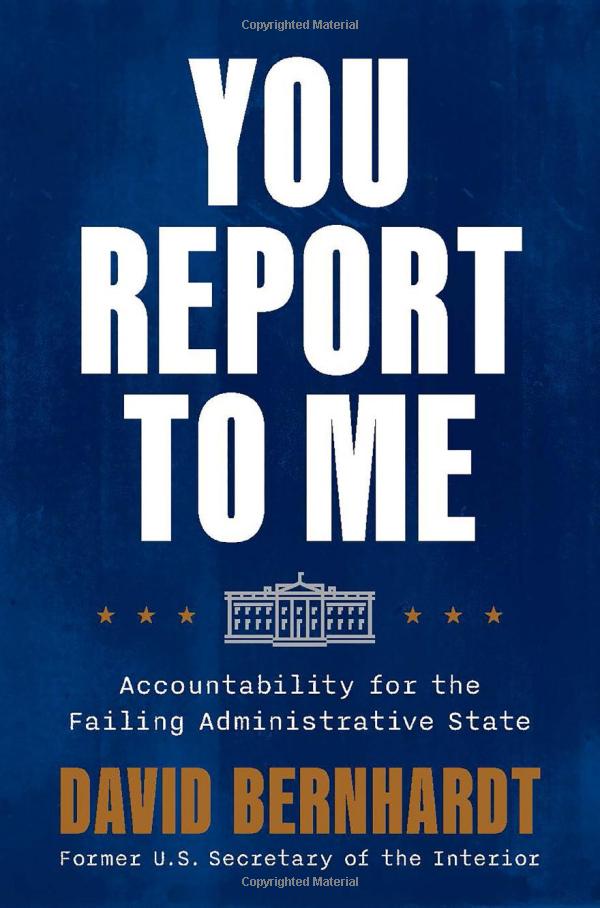Draining the Swamp
Unwarranted job security for unaccountable federal bureaucrats emboldens their resistance, enables their agenda, and makes it difficult to implement policies to which they object.
This essay originally appeared in Law & Liberty on May 15, 2023 as “A Peek Inside the Undrained Swamp” (here).
Thanks to Power Line, Real Clear Politics (here), and Real Clear Books & Culture (here)!
Most critics of the administrative state are academics—political scientists or law professors—who approach the subject from a theoretical perspective: criticizing Chevron deference, advocating for revival of the nondelegation doctrine, and sometimes even challenging the constitutionality of administrative agencies altogether. David L. Bernhardt’s You Report to Me, in contrast, is a first-person account of a high-level federal official, revealing how the bureaucratic swamp really works—an expose of the administrative state from the inside. Part government service memoir, part administrative law primer, part civics lesson, and part cautionary tale, You Report to Me goes beyond textbook nostrums to explain in practical terms how effective political leadership can restore accountability to an often-dysfunctional executive branch.

Bernhardt is well-suited for this task, having served as President Trump’s Secretary of the Interior, with previous stints as Deputy Secretary and (under President George W. Bush) Solicitor of the Department of the Interior. His tenure as a cabinet officer coincided with the restoration of America’s energy independence (among other policy successes), which required significant regulatory initiatives involving federal lands within the purview of the Department of the Interior. Bernhardt is also a longtime lawyer in Washington, D.C. He is, in short, a seasoned veteran of the administrative state who knows the ropes. The title of the book is drawn from President Trump’s Oval Office response when Bernhardt, then filling in as Acting Interior Secretary due to the resignation of Ryan Zinke, asked “Who do I report to?”
Bernhardt describes various factors that contribute to the bureaucratic morass within administrative agencies: badly-written statutes that provide little guidance to regulators; labyrinthine organizational structures within agencies, padded with layers of career civil servants; weak agency heads unwilling (or unable) to manage the sprawling operations they oversee—serving as mere “figureheads” and allowing their agencies to run on “autopilot”; and even chaotic White House staffing arrangements that impede vital communication between agency heads and the president to whom they report. Fixing some of these problems requires action by Congress or (in the case of Chevron deference) the Supreme Court, but–in Bernhardt’s telling–a strong executive can make progress with forceful, decisive management. However, it is not easy, and systemic problems elude simple solutions.
The sobering cautionary tale in You Report to Me is that even if an executive follows Bernhardt’s advice for managing the bureaucracy, any improvements are likely to be ephemeral—lasting no longer than the administration then in charge—absent significant civil service reforms. Presidents come and go, but currently the tenured bureaucrats who staff executive branch agencies constitute a permanent regime. Imposing lasting accountability on career staffers will be a daunting task.
The federal government has grown to a behemoth that would be incomprehensible to the Framers. Bernhardt reports that “The executive branch as a whole currently employs 2.2 million full-time, part-time, seasonal, and temporary staff.” At the same time, federal laws and administrative regulations have become both unmanageably prolix and tortuously convoluted. The challenge is ensuring that this vast cadre of personnel follows the applicable law and—to the extent not inconsistent–executes the policy directives of the duly-elected head of the executive branch, the President of the United States. If federal bureaucrats fail to follow the law or to obey the policy directives of elected officials to whom they report, the premise of constitutional democracy—consent of the governed—is defeated.

Bernhardt, who has returned to private practice but also serves as chairman of the pro-Trump America First Policy Institute‘s Center for American Freedom, offers some keen insights into the internal dynamics of the Trump administration. Bernhardt’s considerable experience as a politically-appointed federal regulator and “principal officer” (requiring Senate confirmation) equips him to make detailed technical recommendations regarding “draining the swamp,” as well as anecdotal tips on “driving change as a political appointee.” Bernhardt believes that the key to being an effective senior official is “a lot of learning and engagement,” including thorough familiarity with the official’s legal authority across the range of the relevant subject area responsibilities, having clearly-defined policy goals, and a desire to be in charge.
According to Bernhardt, the lack of such preparation and direction allows the agency’s career staff (which he contends overwhelmingly harbors a left-of-center ideology) to run amok. The most disturbing theme in You Report to Me is the resistance often faced by a Republican president on the part of rank-and-file bureaucrats employed by federal agencies. (He provides numerous examples, from Interior and other departments.) The prevailing political views in the Nation’s Capital (where many residents work for the federal government) skew markedly Democratic. In the 2016 presidential election, voters in the District of Columbia favored Hillary Clinton over Donald Trump by a margin of 91% to 4%. In 2020, D.C. voters favored Joe Biden over President Trump by a margin of 92.1 % to 5.4%. No major city in the United States has an electorate as lopsidedly partisan as Washington, D.C.’s.
The staffers populating federal agencies wield power, even under Republican presidents, because numerous legal protections give them nearly iron-clad job security. Bernhardt usefully sketches the evolution of federal employment from the so-called “patronage” system of the 19th century (essentially at-will employment subject to wholesale replacement by each presidential administration) to the progressive reform of civil service. Bernhardt explains that
After a discontented job seeker assassinated President James Garfield in 1881, President Chester Arthur heeded the public call to end the spoils system. The Pendleton Civil Service Reform Act of 1883 replaced patronage appointments with a merit-based selection process that allowed individuals to gain federal employment through their performance on examinations.
The Pendleton Act did not impose restrictions on termination of federal employees (other than protections for after-hours political activities) out of well-founded concern that the “power of dismissal” was essential to address “incompetency, negligence, insubordination, insolence, and every other mischief in the service.”
Alas, this sensible stance did not last. Termination protection crept in incrementally, by executive order and statute, initially for military veterans (following WWII) and eventually for all employees. Then, nearly a century after the Pendleton Act, Congress enacted the rigid scheme now in place, the Civil Service Reform Act of 1978. Today, most federal employees enjoy four separate forms of job security: the elaborate protections of the CSRA, union grievance procedures for the majority of the federal workforce covered by a union contract, discrimination claims filed with the Equal Employment Opportunity Commission (the overwhelmingly majority of which are meritless), and whistleblower protection claims filed with the Office of Special Counsel (which substantiates only 3 percent of reports filed).
The cumulative impact of these measures is to make firing a federal employee—no matter how incompetent or insubordinate–so difficult that few managers even try. In 2020, federal agencies fired fewer than 4,000 out of 1.6 million tenured civil service employees. As a result, Bernhardt contends that “The federal government now employs an insulated civil service lacking accountability…. The upshot is that the federal bureaucracy is dominated by ideological liberals who their supervisors believe are almost impossible to fire.”
This is not just an abstract concern. Bernhardt provides appalling examples of “intransigent career employees” working to stymie and impede the agenda of the Trump administration, through foot-dragging investigations; declining to enforce valid legal claims; burying unfavorable data, documents, and arguments; misleading supervisors; failing to communicate with political appointees; slow-walking the drafting of proposed rules; and even misstating legal arguments. In many cases, critical initiatives of the Trump administration succeeded only because the small number of political appointees within an agency took over the task to prevent bureaucratic “resistance.” The federal government has become, in Bernhardt’s estimation, an “unaccountable bureaucracy.”
The pervasive degree of recalcitrance by federal bureaucrats undermines the foundation of representative self-government. If agency personnel refuse to implement the policies of a duly-elected executive and his designees, the disobedient bureaucrats are rogue actors—scofflaws. Bernhardt warns that agency staff “are not in government to be policy zealots untethered by law.” This is a major—and recurring–theme in You Report to Me. Bernhardt confides that his “greatest concern regarding our nation’s government [is] well-meaning employees who advocate for their own pet cause rather than serving as neutral, technically competent administrators.”
What is the solution? Bernhardt exhorts political appointees to manage career staff more forcefully—holding subordinate civil servants accountable if they fail (or refuse) to do their jobs. “When political leadership is unwilling to hold career staff accountable, functionaries who are neither elected nor appointed can wield power in a thick swamp of regulatory and enforcement actions.” More concretely, Bernhardt suggests specific reforms to our civil service system: streamlining the processes for disciplining and dismissing poor performers; streamlining the collective-bargaining process, including eliminating taxpayer-subsidies for union officers performing union business; and eliminating civil service protections for agency staff who serve in policy-influencing roles.
President Trump implemented some of these reforms by executive order, which—predictably–were challenged in court by the galaxy of unions representing federal workers. Bernhardt provides a summary of the litigation, concluding that
In total, seventeen federal judges heard union challenges to the executive orders—eleven appointed by Democratic presidents and six appointed by Republicans. Ketanji Brown Jackson [then serving on the district court for the District of Columbia] was the only one of those judges to rule against the orders [she was eventually overruled by the D.C. Circuit], but her injunction prevented the Trump administration from implementing them for over a year.
What was the fate of Trump’s reforms? Spoiler alert: the swamp—what some pundits call “permanent Washington”–won. Shortly after taking office, President Biden rescinded Trump’s executive orders, and then Biden appointed the errant Judge Jackson to the U.S. Supreme Court! Democratic elected officials support the bureaucracy, and vice versa. This is the Deep State taking care of itself.
The unglamorous details of civil service reform provide a practical blueprint for draining the swamp. It would behoove scholars and policy wonks studying the administrative state to give greater attention to such matters. Reining in Chevron, resurrecting the nondelegation doctrine, and other topics popular among academics won’t fix a broken system as long as unaccountable, partisan bureaucrats run the agencies. “We the people” will not be in charge of the United States unless and until federal employees understand that they are accountable to the electorate, and not free agents. This is the important lesson of You Report to Me.
































